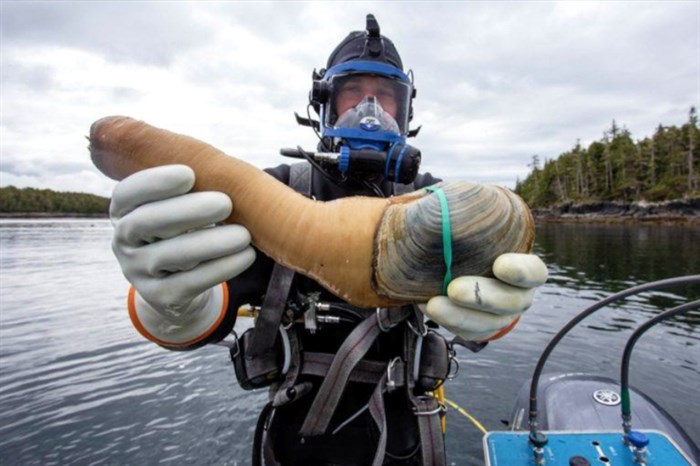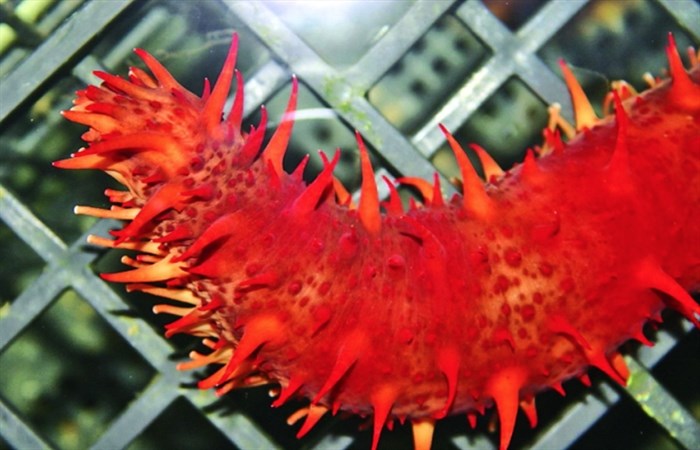
A diver presents a geoduck clam for the camera during harvest off the coast of British Columbia in this undated photo.
Image Credit: SUBMITTED / Maxwel Hohn
December 08, 2020 - 7:30 PM
When foreign markets closed their doors to seafood imports during the COVID-19 pandemic, B.C. fisheries suffered huge losses this year.
Some sympathetic consumers here at home abandoned the cheaper, farmed products from other countries to pay a little more for fresh, locally sourced wild catches, as suppliers and retailers identified new ways of getting that seafood on the shelf.
By population alone, domestic appetites will never replace markets abroad, valued at $1.4 billion annually, but there’s hope the trend will continue post-pandemic as British Columbians come to appreciate the importance of food security and the economic wellbeing of coastal communities.
But there are some more obscure fisheries that will never secure the support of mainstream seafoods like crab, prawns, or halibut. So while B.C.’s exotic catches normally end up abroad, it’s worth remembering the harvesters remain here at home — neighbours and friends, spokes in the local economy as important as any other to keep things spinning.
Here are five of B.C.’s top exotic seafood exports you can try at home.
Geoduck Clam
What it lacks in good looks, it compensates with attitude. Pronounced GOOEY-duck, this is the world’s largest burrowing clam with an extraordinary lifespan of about 140 years (no, that’s not a typo). Native to the coasts of roughly Washington and B.C., the filter-feeder is distinguishable for its ability to far outgrow its puny shell, reach up to two pounds in weight and telescope its siphon more than one metre from the safety of its sandy burrow to feed off nutrients of the sea.
Divers, with a surface air supply and 70 pounds of weights, walk around the ocean floor seeking out the siphon tip poking through the sand then use pressurized water to liquefy the surrounding area, allowing for easy extraction. Because every geoduck is harvested by hand, there is zero bycatch.
More adventurous eaters can boil the stomach, but the siphon and belly is more commonly consumed in thin slices and eaten raw, maybe with a little lemon juice, olive oil and chives.
With a texture sometimes compared to cartilage, geoduck has a crisp bite. It’s mildly salty with a savory-sweet depth and a familiar clam flavour. Other popular preparation methods include civici or stir fry.
Lower Mainland chefs of Chinese cuisine have elevated geoduck to a respectable status, and are chiefly responsible for creating a demand in China that imports 90 per cent of B.C.’s geoduck, valued at about $50-million in 2019.
Many recipes can be found on the Geoduck Harvesters Association of Canada’s website, along with a step-by-step guide to breaking down the parts.
It is found widely in Chinese and Japanese restaurants, and at specialty retailers like T&T Supermarket for about $20 to $30 per pound.
Herring Roe
Throw out your impressions of salmon eggs and even caviar. Herring roe, or kazunoko, is a delicacy in Japan prized for its colour, shape and unique crunch. Yes, crunch. Think of a bright yellow, wing-shaped morsel the size of a thumb with the texture of biscotti.
B.C.’s cool northern waters are known for herring that produce some of the more perfectly shaped clusters of roe, loaded with protein, nutrients and omega fatty acids.
Kazunoko has held a special status in Japan since at least the early 19th century as a symbol of prosperity and still today is a customary indulgence for New Year’s celebrations.
Herring roe is best eaten raw with a little soy sauce. Increasingly so it’s also been seasoned with squid guts, chilies, or Japanese mayonnaise (much sweeter than the western version). Deep fried kazunoko is also finding a following.
The taste is unpretentiously simple: salty and fishy. But it’s the crunch that defines a good grade of kazunoko, as emphasized in a jingle for the Yamaka brand, loosely translated as, “Eat kazunoko together! Crunchy, crunchy!”
B.C.’s herring roe is sold almost exclusively to Japan, with a few very small markets at home and in China. Even in high-end Japanese restaurants, it’s hard to find on menus, but specialty retailers like Fujiya Stores sell it for about $33 per 470 grams.
Long before the Japanese popularized herring roe, north coast First Nations have prized a more advanced stage of the egg commonly referred to as roe on kelp. K’aaw, as it’s called in Haida, is a traditional food that comes seasonally after the herring spawn in the kelp forests. (Today it is mostly cultivated through sustainable farming.) Once the eggs bind firmly to the plant they are harvested as one, in long thin sheets, and cut into bite-sized pieces. It’s commonly salted and either eaten raw or pan-fried.
Giant Red Sea Cucumber

Like chicken, the neutral flavour of giant red sea cucumber allows it to absorb the flavours of the dish.
Image Credit: SUBMITTED / C. Pearce / Fisheries and Oceans Canada
There are about 30 species of sea cucumber off the B.C. coast, but only the giant red is harvested commercially — three-million pounds of it in B.C. last year.
These creatures are soft, gelatinous tubes with leathery skin (contrary to their slimy appearance), a reddish-orange colour and rubbery yellow spikes. They can grow to about two-feet long and weigh up to two pounds.
Giant reds are a highly sustainable food hand picked from rocky shorelines and kelp beds, where they play a useful role breaking down dead organic matter. They have no true brain, but a ring of neural tissue surrounding the mouth.
The skins are often removed by harvesters for sale as a traditional Chinese medicine (for heart and kidney ailments), allowing at-home cooks to jump straight to the meal preparation with the meat, of which there is very little of in each animal. Once seperated it has a less-intimidating appearance comparable to sliced chicken breast — pink-ish beige and smooth.
Some compare its texture to a scallop, yet noticeably more tender. The desired consistency in many Chinese recipies is somewhat more gelatinous while still remaining solid.
The taste is neutral, or bland. But again, like chicken, this allows it to absorb the flavours of the dish.
It’s popularly diced into stir fries, but as with scallops or prawns, it can be utilized in almost any manner imaginable by a willing cook.
Giant red sea cucumbers can be found in seafood markets across the Lower Mainland and online ordering sites for about $25 per pound.
Sea Urchin Roe
When it comes to sea urchin, the term ‘roe’ is really a euphemism for gonads (and has been falsely labeled by many cultures as an aphrodisiac). But don’t let that turn you away. Sea urchins have earned solid footing in the culinary world as a most satisfying, savoury custard of the sea.
The sea urchin, or more specifically the popular Pacific red sea urchin, lives in our shallow waters and rocky shores, feeding on seaweeds and algae. Its mouth is located on its underside and its anus at the top. Its hard spherical shell radiates with hundreds of sharp, defensive spines it can use as stilts to walk around the ocean floor.
Divers pick up the urchins by hand, making this another sustainable fishery with zero bycatch.
Inside the shell, it’s remarkably cavernous, mostly containing sea water, with a small stomach and digestive tract surrounded by five crescents of gold-coloured roe.
For eating, the shell is cut open with scissors and the roe spooned out. With a quick rinse in salted water it can be eaten on the spot in its purest form.
It has a thick, buttery texture with a sweet and briny taste, and is high in protein but low in fat and calories.
The uses of sea urchin roe are limitless: uni donburi (sushi), sea urchin stuffed calamari, sea urchin pasta, sea urchin teriyaki sauce, sea urchin on a cheese platter or added to a dollop of vanilla ice cream are but a few ideas to get you started. Many more can be found on the website for the Pacific Urchin Harvesters Association.
Sea urchin is widely available in restaurants and markets at affordable prices.
Seaweed
Seaweed may be the least challenging food for most to eat on this list, but it’s also the most overlooked considering there are 630 species in B.C. waters but we often only find it as a background flavour in a handful of dishes.
Seaweed production has doubled around the world in the past decade as a kind of miracle plant because it requires only seawater and sunlight to grow, provides habitat for other sea life, mitigates ocean acidification and acts as a powerful carbon sink that eclipses the capacity of land-based forests. It’s good for the planet but excellent for humans — we’re talking about protein, potassium, magnesium, Vitamin B12, iodine, omega-3 fatty acids, antioxidants, and loads of calcium.
Best of all is the taste, the deepest of umami flavours (with the possible exception to the darkest mushroom or black truffle) with the added kick of that salt-water sweetness.
If you’re just starting out with seaweed, try it in its dehydrated form and add it to seasonings, salads and soups. There are exceptional small-scale B.C. harvesters like Canadian Kelp and Dakini Tidal Wilds on Vancouver Island, and BC Kelp in Prince Rupert with an assortment of dried, locally-sourced varieties from pristine, government-licenced tenures.
Turning the industry on its head is Sidney-based Cascadia Seaweed. They’re the first operation to go into full-scale farming, building nurseries, investing in infrastructure and growing the sugar kelp, alaria and dulse varieties from seed to maturity. Cascadia’s primary focus is consumer packaged products — ready to eat seaweed snacks. They work in strict partnership with B.C. First Nations to share the economic opportunities and plan to have 500 hectares of B.C. farming tenure (1,000 football fields) in place by 2025, with the goal of becoming North America’s largest provider of cultivated seaweed.
A sneak-peak of their spring product lanuch inclueds a seaweed jerky (with the texture of meat, but with that unmistakable salt and umami flavour) and of course seaweed salads (as a wet vegetable, seaweed has a firm, clean bite that’s slightly chewy but fresh within cool northern waters).
Whether dry, wet, or prepared, a little B.C. seaweed goes great with any of the seafoods mentioned in this series. Experiment and enjoy.
— This story was originally published in the Prince Rupert Northern View.
News from © iNFOnews, 2020